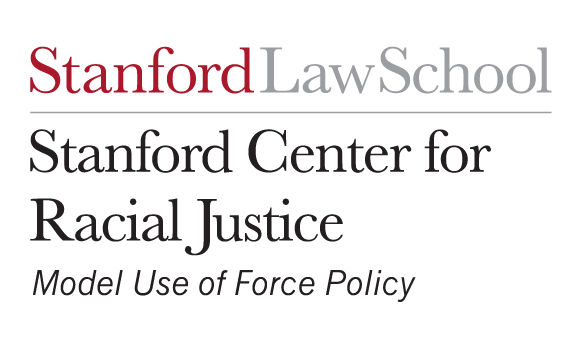Do Use of Force Policies Matter in Excessive Force Cases in Federal Court?
The Stanford Center for Racial Justice has begun publishing chapters of our Model Use of Force Policy in beta release. The Model Policy is intended to contribute to the long line of efforts to improve and reform policing and promote practices that will be fair, safe, and equitable for everyone. Below is the first of several essays by our staff examining the role of use of force policies and how they intersect with legal proceedings in a variety of situations. Read Chapter 3 of the Model Policy—Speaking Techniques, Physical Controls, and Personal Body Weapons—here.

On August 24, 2019, a young Black man named Elijah McClain was the victim of a brutal assault by multiple police officers in Aurora, Colorado. He was on his way home from a convenience store, listening to music on his headphones. Following a 911 call by a passing driver who reported McClain as “sketchy,” officers seized McClain based on little more than determining that his actions were “suspicious” and proceeded to inflict pain techniques for 18 minutes— including 15 minutes while McClain was handcuffed. During the assault, officers used two carotid holds—a neck restraint that blocks the carotid arteries’ blood flow to the brain—to McClain’s neck, an armbar hammerlock to his shoulder, and a forceful pain technique which separated McClain’s bicep and tricep muscles. McClain was also later injected with ketamine despite not displaying “any medical conditions that could be treated with ketamine.” On his way to the hospital, McClain went unconscious and died days after the incident.
In August 2020, the family of McClain filed a lawsuit in federal court against the officers and the City of Aurora. The lawsuit claimed the officers violated the Fourth Amendment by depriving McClain of his right to be free from unreasonable seizures—in other words, using excessive force. However, the claim never made it to trial. Before the court could complete the case, the family settled with the city for $15 million.
We discuss below whether the Aurora Police Department’s policies and the officers’ training would have made a difference in holding the officers accountable for McClain’s death had the case gone to trial. We also discuss how SCRJ’s Model Policy would apply to the facts surrounding McClain’s encounter with the Aurora police.
How do federal courts evaluate claims of excessive force?
When reviewing an injured person’s claim of excessive force, federal courts typically seek to answer two main questions: (1) whether the officer acted reasonably; and (2) whether the officer would have known the officer was acting unreasonably. This approach is known as the qualified immunity standard, and it immunizes officers from monetary liability for using force against individuals. In summary, qualified immunity doctrine protects officers from court proceedings unless the officer violated a clearly established right that every reasonable officer would have known.
Did the officers act reasonably?
Courts analyze the first question by examining the “facts and circumstances” the officer faced “from the perspective of a reasonable officer on the scene, rather than with the 20/20 vision of hindsight.” This is known as the “reasonable officer” standard. The Supreme Court has instructed courts to consider certain factors—such as the severity of the crime, the danger to the officers and public, and the risk of flight or resistance—to evaluate the reasonable officer’s conduct. However, there is a lack of clarity from the Supreme Court and other courts about the details of how courts should conduct the evaluation of the reasonable officer. This lack of clarity contributes to “haphazard, inconsistent decisions” where lower courts insert their own ideas of reasonableness instead of looking to definitive evidence of reasonableness—such as the height and weight of an officer, the officer’s level of training and years of experience, or the officer’s compliance with the department’s use of force policies.

A court could allow evidence of the local police agency’s use of force policies and training to help inform whether the officer complied with that policy and/or training—and therefore whether the officer’s actions were reasonable. After all, most organizations expect reasonable employees to follow their employee guidelines. In McClain’s case, the court potentially could have examined the Aurora Police Department’s use of force policy. That policy might have informed officers on how to treat situations like the events that resulted in McClain’s death.
However, some courts do not allow the local agency’s use of force policy into evidence. Additionally, under the Supreme Court “reasonable officer” standard as articulated in Graham v. Connor, some federal courts have ruled that “a violation of departmental policy does not equate with constitutional unreasonableness.” And the 10th Circuit Court of Appeal that oversees Colorado federal courts views use of force policies as largely irrelevant to the reasonableness calculation. Consequently, use of force policies may or may not be allowed in federal court to help inform the reasonableness question and—even when allowed into evidence—will likely not determine the ultimate outcome of the question of whether the officer acted reasonably.
Would the officers have known their actions were unreasonable?
The second question requires courts to evaluate whether the officers would have known their actions were unreasonable. Essentially, courts attempt to answer whether the law was sufficiently clear that the alleged conduct was constitutionally unreasonable. If not, the court grants the officer qualified immunity and the case is over, without any trial or accountability for the officer’s actions.
Here too, one would expect a court to look at the local law enforcement agency’s departmental policy and whether the officer knew that—according to the policy—they were acting unreasonably. But courts largely do not utilize use of force policies to establish that officers would have known their actions were unreasonable. Instead, courts usually look at previous court decisions to see whether there was clearly established law concerning the conduct. The Supreme Court has also explained that “[e]ven if an officer acts contrary to [their] training . . . that does not itself negate qualified immunity.” This approach to qualified immunity—reviewing judicial decisions instead of the facts of the case—has been extensively criticized.
Under this part of the qualified immunity analysis, the court examining the McClain family’s claim might have looked at previous excessive force cases in Colorado or other federal courts, instead of reviewing Aurora’s policies, to determine whether the Aurora officers would have known their actions were unreasonable.
The above discussion reveals that use of force policies and violations of those policies are often not examined by federal courts in excessive force lawsuits, and even when the court uses this evidence, the policies will usually not determine the outcome of an officer’s federal civil liability.
Why are use of force policies important?
Use of force policies are important even though they likely will not change the outcome of a federal civil rights claim alleging excessive force. The policies reflect the expectations of police department leadership and the standards to be followed by its well-trained officers. Use of force policies also can help reflect community values for what is reasonable and how a community might expect their police department to use force. For instance, one scholar has recently urged that cities and municipalities should find ways to ensure the public is deeply involved in developing department use of force policies. In turn, use of force policies can improve the perceived legitimacy of the department and create a sense of procedural fairness among those most impacted by policing.
Further, research conducted over the past several decades consistently suggests that more restrictive use of force policies are correlated with reduced police killings—and are not correlated with increases in crime, harm to officers, or other types of negative effects. For example, after Seattle adopted its “necessary” standard, the city reported a significant reduction in the number of force incidents without a decrease in officer or civilian safety. Accordingly, departments can update use of force policies to reflect community values while maintaining the safety of their officers.
Did the Aurora officers violate provisions under the Model Policy?
Our Model Policy aims to provide a tool for local law enforcement agencies to work alongside their community to develop a use of force policy that comprehensively addresses fair, safe, and equitable practices to reduce fatal and non-fatal uses of force.

The officers confronting McClain used a variety of speaking and physical force techniques. Under Chapter 3 of the Model Policy, physical force is an option of “last resort” which officers can use only after exhausting all non-force options and meeting the authorization standards under the Policy. Officers must “de-escalate their use of force as soon as a resisting subject’s behavior no longer justifies the level of force being used.” To de-escalate a situation, officers must first attempt speaking techniques, initially using verbal persuasion, then using verbal commands if verbal persuasion is ineffective. Additionally, before using more severe levels of force, officers must “consider the totality of the circumstances and whether there are factors that might affect a subject’s ability to comply with a verbal command . . . [including] hearing disabilities, language barriers, and/or mental illnesses.”
In the case of McClain, the officers failed to de-escalate the situation. Instead, the officers began their interaction with McClain by resorting to a verbal command—“Hey, stop right there.” Although verbal commands are speaking techniques suggested by the Policy, the officer escalated to using a verbal command rather than using verbal persuasion—a tool of first resort—to gain control of McClain.
After being commanded to stop, McClain told the officers, “I have the right to walk to where I am going.” Immediately after this statement, one officer closed in on McClain and grabbed McClain’s left arm and stated, “I have a right to stop you because you’re being suspicious.” This grabbing of McClain’s arm is defined as a “physical control” under the Model Policy.
The Model Policy allows officers to use physical controls with an individual—such as wrist locks, twist locks, or arm bars. However, before officers use physical controls, officers must use speaking techniques to gain control of an individual, and the force must be authorized under the policy. If speaking techniques fail, an officer may use physical controls if the individual’s “physical actions become actively resistant to a point that prevents an officer from making an arrest,” or if the officer believes they are “necessary to prevent imminent bodily harm to the officer, the [individual], or another person and that belief is consistent with available information.”
The officer’s arm grabbing violated the Model Policy because the officers would first be required to use speaking techniques and McClain’s “physical actions” were not “actively resistant” to a point that would prevent arrest.
Notably, after the arm grab, McClain pleaded to the officers that he was “an introvert,” to “please respect his boundaries,” and that he was “wearing his headphones . . . trying to stop his music to hear [the officers’] command.” This suggests that the totality of the circumstances, including the “factor that might affect [McClain’s] ability to comply with a verbal command” would not support the arm grab, much less any escalation in force.
Yet, the officers continued to escalate the amount of force applied, including the use of tactics that are considered personal body weapons. The Model Policy defines personal body weapons as the “use of the officer’s body parts . . . by means of kinetic energy transfers (impacts) to gain control of a subject.” Officers may not use personal body weapons—such as palm heel strikes, common fist strikes, elbow strikes, and front and rear takedowns—unless the officer, after first using speaking techniques and physical controls, is unable to take control of the individual and “the [individual’s] physical actions become actively resistant to the point that they pose a substantial risk of causing imminent bodily harm.”
After the initial arm grab by one officer, a second officer grabbed McClain’s other arm. “Stop tensing up,” the officers ordered McClain. McClain continued to plead with the officers to “Please leave [me] alone.” At this point in the interaction, one armed officer used a speaking technique and two officers used a physical control to take McClain under their control. The record does not show any facts to support the notion that McClain’s “physical actions [became] actively resistant to the point that [McClain] pose[d] a substantial risk of causing imminent bodily harm.”
The available information to the officers came from a nearby motorist’s call to 911 dispatch; the caller stated McClain was acting “sketchy,” had a ski mask on, was making “signs with his hands,” and did not appear to be armed. Additionally, the officers’ own perception indicated that McClain was holding a single shopping bag and did not appear armed. Despite there being no available information indicating it was necessary to prevent imminent bodily harm, the officers escalated this situation even further by first frog marching McClain to a wall, then applying a carotid hold to block blood supply to McClain’s brain, and finally tackling McClain to the ground. These actions would be violations under the Model Policy.
The officers had no information that McClain was at risk of performing actions that caused any imminent bodily harm. McClain’s mere “hesitancy . . . in following [the officers] commands” did not justify the use of physical controls or personal body weapons. Instead, the officers should have “de-escalate[d] their use of force” because McClain’s actions and the officers’ knowledge of the situation “no longer justifie[d] the level of force being used.”
There was some information reported that an officer claimed McClain reached for an officer’s gun while officers had a hold of McClain’s arms—and after officers had frog marched McClain to a grassy area. This statement has been heavily disputed by McClain’s family because of the inconsistency with which officers recounted the details, as well as a statement by an officer that he “did not feel any contact with his service weapon.”
After being taken to the ground, the officers continued to inflict physical compliance techniques and eventually paramedics injected ketamine into McClain’s body. McClain later died.
Do use of force policies matter?
Would the Model Policy have had an effect on the officers’ behavior had the Aurora Police Department implemented it prior to this case? Written rules alone are insufficient to assure proper conduct—and factors such as training, experience, and police culture can influence individual officer behavior. Further, the limited influence that use of force policies have on an officer’s federal civil liability also raises questions about the role of providing clear standards on the use of force.
We believe clear standards are essential. The standards provide a baseline reflecting the expectations of the department and the community. They also are a basis for training and a source of ongoing reference for officers who want to refresh their understanding of what is expected of them. Policies also ultimately help shape what a reasonable officer can and should do in a variety of circumstances.
Whether using our Model Policy or similar guidelines, police agencies and communities should work together to form a common understanding of their visions for public safety. These visions should be shaped by information police agencies learn from the most successful police departments across the nation and informed by dialogue with members of communities who are most impacted by policing. While much more is needed to improve public safety, a police department’s use of force policy which considers fair, safe, and equitable values, leading practices, and community voices is essential to achieving fair, safe, and equitable outcomes.
Disclaimer: The facts cited above were assumed to be true based upon allegations in the federal civil complaint in the McClain case, as well as public news sources, and have not been evaluated for accuracy. The above analysis reflects the opinions of our staff and is intended for educational purposes and policy discussions.
